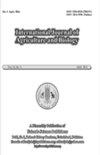Root Traits Responses to Irrigation Intervals in Rice (Oryza sativa)
Q2 Agricultural and Biological Sciences
引用次数: 6
Abstract
Drought is one of major abiotic stresses that effect rice production. Roots play vital role in absorption of water and nutrients from soil contributing for drought tolerance. The present study quantified the effects of different irrigation intervals on root development and agronomical traits of three Egyptian rice cultivars, Giza177, Giza178, Sakha107, IET1444 as a popular drought tolerant and Moroberekan as control genotype. Irrigation treatments were imposed 15 days after transplanting and applied for every 4, 8 and 12 days during 2018 and 2019 rice growing seasons. The results showed the reduction in root architecture traits with prolonged irrigation intervals. A significant decrease in plant height, number of panicles plant-1, grain yield (t ha-1) and relative water content, while sterility (%) and water use efficiency significantly increased over irrigation intervals. The highly significant and positive correlation was found among grain yield and root:shoot ratio, relative water content and number of panicles plant-1, while the negative correlation was with root xylem vessel number and sterility. It was concluded that, the drought reduced the grain yield and its components due to poor developed root system. Moroberekan and IET1444 genotypes can be used as a donor parent for rice breeding program. Further studies are also required to identify factors that contribute to the high yield potential of both Giza178 and Sakha107 under different water stress condition. © 2021 Friends Science Publishers水稻根系性状对灌溉间隔的响应
干旱是影响水稻生产的主要非生物胁迫之一。根系在吸收土壤水分和养分方面发挥着至关重要的作用,有助于抗旱。本研究量化了不同灌溉间隔对埃及三个水稻品种根系发育和农艺性状的影响,Giza177、Giza178、Sakha107、IET1444是一个受欢迎的耐旱基因型,Moroberakan是对照基因型。灌溉处理在移植后15天进行,在2018年和2019年水稻生长季节每4天、8天和12天进行一次。结果表明,随着灌溉间隔的延长,根系结构特征降低。随着灌溉间隔的延长,株高、穗数、籽粒产量(t ha-1)和相对含水量显著降低,而不育性(%)和水分利用效率显著提高。籽粒产量与根冠比、相对含水量和穗株数呈正相关,与根木质部导管数和不育性呈负相关。结果表明,干旱导致根系发育不良,降低了粮食产量及其组成部分。Moroberekan和IET1444基因型可作为水稻育种计划的供体亲本。还需要进一步的研究来确定在不同的水分胁迫条件下,Giza178和Sakha107高产潜力的因素。©2021 Friends Science出版社
本文章由计算机程序翻译,如有差异,请以英文原文为准。
求助全文
约1分钟内获得全文
求助全文
来源期刊

International Journal of Agriculture and Biology
AGRICULTURE, MULTIDISCIPLINARY-
CiteScore
1.70
自引率
0.00%
发文量
40
审稿时长
5 months
期刊介绍:
Information not localized
 求助内容:
求助内容: 应助结果提醒方式:
应助结果提醒方式:


